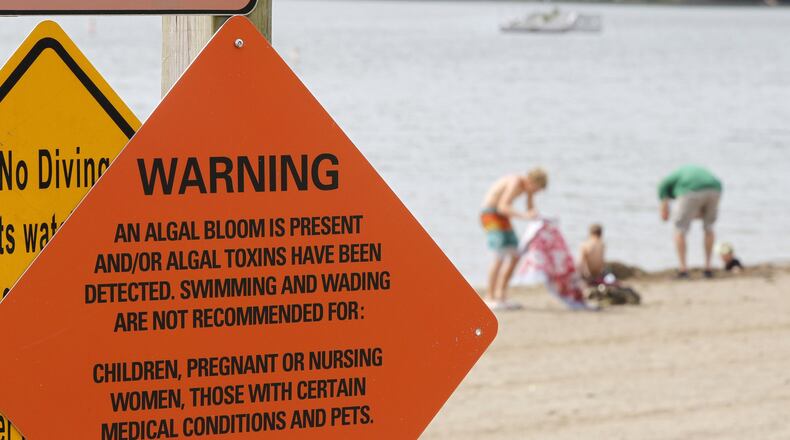Although some algal blooms are green algae and not harmful, they can produce toxins harmful to swimmers. The toxin is not visible, but can give the water itself a blue-green tint, said Eric Heis, public information officer for the Ohio Department of Natural Resources.
The bloom was likely caused by heavy rains in the region, Heis said.
MORE: Harmful algae detected at Caesar Creek Lake beach
Signs are posted warning park attendees of the algal bloom, but people can still swim at their own risk. Caesar Creek park officials posted on Facebook that so far no one has reported getting sick.
The beach at Caesar Creek has eight micrograms of the microcystin toxin per liter of water. The threshold for a recreational Public Health Advisory is six micrograms per liter. If there were 20 micrograms of microcystins per liter of water, the state would advise everyone to stay out of the water.
Swimming and wading are not recommended for children, pregnant or nursing women, those with certain medical conditions and pets. Heis stressed that while it is not recommended, anyone can get in the water.
“If you’re in the water and you feel light-headed or just don’t feel well, get out of the water,” Heis said.
If someone does go in water with an algal bloom, they should immediately rinse off with fresh water after getting out, the Ohio Environmental Protection Agency advises.
The Ohio Department of Natural Resources is testing the water at Caesar Creek daily, but there is no telling when the algal bloom might end. Weather conditions, the depth of the lake and the amount of water flow play into how long the algal bloom may last, Heis said.
Exposure to water with harmful algal blooms may affect the liver, nervous system or skin.
Touching harmful algal blooms, swallowing water with toxins or breathing in water droplets could cause a rash, an allergic reaction, stomach ache or dizziness and a light-headed feeling. Harmful algal blooms are also toxic to pets.
This is the first Recreational Public Health Advisory at Caesar Creek since 2012, the most recent data available, according to the health department. There have been several bacteria contamination advisories due to E. coli found in the water, including one in August 2018 that lasted 15 days. A bacteria contamination alert happens when the level of “bad bacteria” in the water has reached unsafe levels.
RELATED: Here’s what an $8.8 million marina looks like
Only the beaches are tested, Heis said, so other parts of the water could have more or less toxins than the tested areas.
However, Heis said the toxins do not leave the water so camping and other activities at Caesar Creek are safe. And fishermen can eat fish they catch.
“We just ask that people remove the guts and the liver and wash them before eating them, which everyone does anyway,” Heis said.
According to the park office, the HFP Racing Triathlon that was hosted at Caesar Creek this past weekend went on as planned with a swim course in the lake.
Algal blooms have garnered attention in the Buckeye State because of their dangers. In 2014, hundreds of thousands of people in the Toledo area were ordered to temporarily stop drinking water after toxins from algae were detected.
Ohio’s farmers have taken most of the heat for algae because studies have shown runoff from the fertilizers and nutrients that help farmers grow their crops, such as nitrogen and phosphorus, have caused algal to blossom in Ohio’s waters.
The Ohio Farm Bureau has argued for voluntary measures to decrease nutrient runoff and in turn algal blooms. A 2016 study that showed voluntary efforts led to a decrease in the phosphorus applied near western Lake Erie, an area declared “impaired” by the Ohio Environmental Protection Agency last year, Tony Seegers, director of state policy for the bureau said in testimony before the Ohio House in May.
The blooms have become a major problem in all 50 states and their local impact has been felt throughout southwest Ohio.
The blooms commonly form in warmer, more shallow waters, such as the western area of Lake Erie, Grand Lake St. Marys and Buckeye Lake.
Great Lake St. Marys and Buckeye Lake have been under an Elevated Recreational Public Health Advisory since February, according to the Ohio Department of Health. In 2017, Kiser Lake near New Carlisle was overtaken by an algae bloom.
The state has spent billions of dollars on solutions to fix the water quality problem and put in place rules to decrease what some scientists say is the No. 1 culprit of the algae blooms — runoff from farm fields and land near waterways.
To check whether an advisory is in place at a public Ohio waterway or to learn more about harmful algal blooms, go to the Ohio Department of Health's Beach Guard website: https://odh.ohio.gov/wps/portal/gov/odh/know-our-programs/bathing-beach-monitoring/BeachGuard/
About the Author
